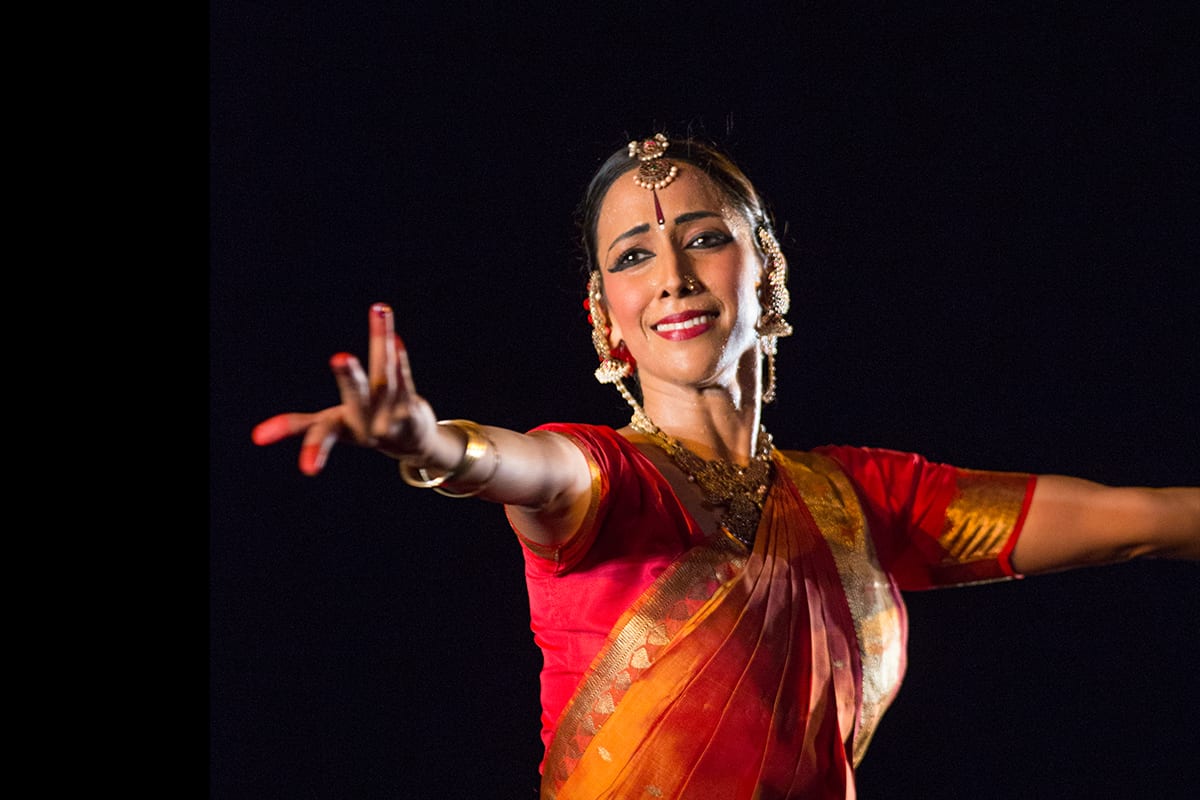I was nervous about watching Mythili from such a perfect seat in the Sadler’s Wells theatre. She had won teenager-me over when she performed at the Bhavan about a decade ago, and I have since then been transfixed by the movement clarity with which she dances, at the speeds that she has mastered. I was worried that she might let me down, that my fandom might prove nothing more than that. I watched with great scrutiny, but speed and clarity passed by me; I found myself instead engrossed in the many transformations she underwent on stage. Crucially, I’m not referring here to abhinaya (expressive dance); she was Mythili throughout and her pieces felt increasingly personal as she led us through her newest work. But her embodiment of sentiment and imagery through nritta (pure dance) was astounding; her incredible mastery of bharatanatyam’s abstract movement was what convinced us of her other-worldliness, as a fire, as a cosmos, as a mother, as a meditation.
In Jwala – Rising Flame, Mythili performs three pieces which together identify the flame as symbolic of the ‘cosmic, temporal and spiritual worlds’. I managed to sit down with Mythili and ask her about it. She first choreographed it in 2015, as a response to a Sanskrit phrase that she translates as “the rising light fills space”. “Flame became this symbol that connected two seemingly opposite experiences,” she explains. “My dad passed away and later that year I had a kid.” Flame became a symbol of both ‘letting go’ and ‘celebration’, and it was this juxtaposition that framed her second piece. Adavu (movement unit) sequences that invoked images of flying sparks introduced flames to us as the destructive focal point of her father’s funeral pyre. Downstage some moments later, Mythili was in her daughter’s bedroom where they were exchanging playful hugs and kisses galore. Upon leaving the room, she gently picked up the candle that had been illuminating it, and this was the one of the most poignant moments in the show. The previously explosive mass of flames that had been central in the experience was now a quiet, portable object – only peripheral, but equally fundamental.
This theme of flame epitomised Mythili’s aesthetic, which is pleasurably familiar in its classicism but excitingly new in its sensibility. There were numerous examples of such an aesthetic preference in her work and the opening to Jwala has to be mentioned. With only both hands lit on an otherwise blacked-out stage, she took the traditional usage of the tripataka hand gesture as fire, and pushed it far out of its symbolic representation to something that actually visually resembled flames. Combining her trademark precision with excellently-designed lighting (reminiscent of Russell Maliphant’s solo choreographies), we were able to indulge in a new development on the traditional hand gesture. I craved more of this intelligent fiddling with tradition, and asked Mythili why she didn’t push conventions further. She explained to me that the classical boundaries are very important to her and, pragmatically speaking, “once you move really far out, to come back in becomes a little tricky.”
I was beyond delighted to be able to speak to Mythili one-on-one and our conversation spanned how to treat audiences, her relationship with her brother and musical collaborator Aditya, the way that social media is changing the artistic landscape, and the importance of both acceptance and ‘feeling shit’ in the studio, among other things. A full transcript is available at www.rediscoveringdance.wordpress.com.
